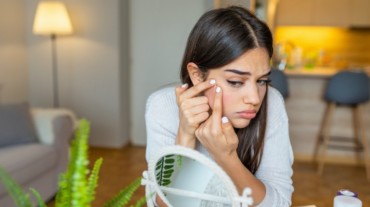
So many of you use or hear the blanket term ‘breakout’ to describe all forms of acne, but the truth is not all types of acne spread across the skin. Acne is one of the most common skin conditions and is caused by clogged skin pores, caused as a result of excess production of oil (sebum), bacteria, hormone fluctuations, dead skin cells and ingrown hairs.
Managing and fighting acne involves, to a great degree, the identification of the types of acne you’re experiencing.
These are the two types of acne:
It’s possible to have both types of acne at once and in a few cases, the severity of the breakout may also warrant a visit to the doctor. To understand exactly when dermatologist intervention is critical, we need to understand these two types of acne better.
Non-inflammatory acne includes blackheads and whiteheads. Essentially, this type of acne does not cause swelling. Blackheads occur when a skin pore is clogged by sebum and dead skin cells, leaving the top of the pore open. Whiteheads, on the other hand, form when a pore gets clogged by sebum and dead skin cells, but the top of the pore closes.
Breakouts that are red and swollen are referred to as inflammatory acne. Bacteria plays a role in contributing to the redness and swelling, as well as clogging of pores, along with sebum and dead skin cells.

This type of acne could be painful as bacteria can cause an infection deep beneath the skin’s surface. Papules are also inflammatory acne that occur when the walls surrounding your pores break down from severe inflammation. This results in hard, clogged pores that are tender to the touch and the skin around these pores is usually pink/light red in colour. Cysts may also develop when pores are clogged by a combination of bacteria, sebum, and dead skin cells. The clogs occur deep within the skin, painful and signify severe infection. Unfortunately, this type of acne is most likely to scar.
Looking for products oily and acne-prone skin? Try the Brillare Oil Away Face Wash and the Brillare Oil Away Moisturiser
For minor-to-moderate breakouts, one may use over-the-counter remedies for six to eight weeks to see results. However, severe inflammatory acne takes time to clear up. Hence, it is advisable to visit a dermatologist if the breakouts are severe, large and are not responding to over-the-counter medications.
Additionally, be vigilant of the pain and be on the lookout for any bleeding or release of a large amount of pus. In such scenarios, immediate medical attention is required.
Select Topics of your interest and let us customize your feed.
PERSONALISE NOWSo, while acne is common and highly manageable, being cautious of the type of acne you are experiencing and visiting a dermatologist can ensure your skin stays healthy!